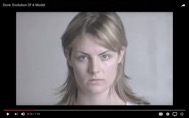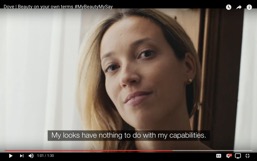"Influential Advertising: Dove and Its Use of Rhetorical Elements in Commercials and Social Media"
|
Paulina AlvarezPaulina Alvarez is an undergraduate student at the University of Central Florida. She is majoring in Advertising and Public Relations and double minoring in Digital Media and Psychology. She wrote this essay for her ENC 1102 class during her freshman year. Paulina wishes to continue learning how visual and written components influence human behavior in order to one day create her own effective advertising campaigns as an art director. Contents |
Results & DiscussionDove displayed a substantial diversity of rhetorical elements in its use of television advertisements and social media sites. Generally, these themes and word choices coincided to generate an overall feeling that portrayed what Dove stands for and hopes to represent through its messages. By analyzing some commercials, survey responses, and social media posts, I was able to discern Dove’s style and tactics and identify what the company feels is important to communicate to its customers/audience. Dove on Television: Beauty, Strength, and PositivityAs I previously mentioned, I chose three commercials to evaluate and base my survey on. The first commercial is called Evolution (FIgure 2), and it shows the process of how a picture of a female model is taken and then photoshopped into the final product that is then published. It demonstrates that the standards or ideas of how women should look do not reflect reality—they are very stereotypical. The video ends with the words “No wonder our perception of beauty is distorted. Take part in the Dove Real Beauty Workshop for Girls. Visit campaignforrealbeauty.ca.”  Figure 2 The second commercial (Figure 3) is called Beauty on Your Own Terms #MyBeautyMySay, and it tells stories of various women who were either told they could not do something because of their appearance or were told they should change a certain feature or characteristic about themselves because it would make them look better. The video then also shows how these women responded and encourage other women to stay true to themselves.  Figure 3 Lastly, the third commercial is called 60th Birthday #RaiseTheBeautyBar (Figure 4), and it is discreetly selling the company’s bar soap. It states, that over the span of 60 years, the product has not changed in the sense of its superior formula; however, during the same time, beauty standards have. The video expresses how Dove is proud to have progressed over time by breaking stereotypes and learning to embrace uniqueness. It thanks its customers by saying, “Together, we redefined beauty… We are proud to have been there with you, caring for you every step of the way. Here’s to the next 60 years.”  Figure 4
Now, after going over each commercial, one can clearly distinguish some of the themes Dove uses in its television advertisements to influence its audience into becoming loyal customers. The company speaks to both its community as a whole as well as its customers as individuals, promoting beauty, strength, and positivity. The company also uses plenty of personal stories from various types of women in its videos with the intention of having the rest of its customers find them relatable. In addition, even though they are not as prominent or direct, Dove still uses the elements of selling or informing its audience about a specific product as well as giving thanks to its customers. Responses to my survey indicate that these methods are for the majority reasonably effective. For example, one participant, after watching the commercials, said: Dove is a brand that celebrates diversity and breaking any ridiculous ideals of beauty that society holds for us. It makes me feel that I, in every way, am able to love myself and treat myself to Dove. Honestly, if I know they stand for something that I believe in, (like empowerment) I'm more motivated to buy it.
Another participant said: [The videos] made me feel slightly proud and happy that there's a company that understands how wrong most places have it, how society has it in telling you exactly how you're supposed to look and there's no exception. Makes me hopeful that maybe more industries will be created around the similar mindset. These responses prove Belch, Lutz, and Mackenzie’s theory of attitude toward the ad. Companies, like Dove, are beginning to focus and concentrate on the likability of the ad rather than trying to just sell a product or service. There has been a shift to emphasizing the message and/or purpose of the company in order to produce positive attitudes from its consumers so that they may become loyal customers (Rimoldi, 2008). Again, Dove has achieved great success in this area, especially with the help of social media. Dove on Social Media: Helping All Women Realize Their Personal Beauty PotentialLooking at Dove’s social media sites, one can detect many rhetorical elements used in each published post. I chose 160 Instagram posts and Tweets to analyze and then assign to a category based on the themes they were displaying. The results can be found in the table below.
One can see that the two most popular themes were Promoting Beauty/Strength/Positivity with 59% and Sharing Personal Experiences with 47%. Through these two subjects, Dove was also able to encourage the community (37%), encourage individuals (23%), sell/inform about a product (18%), and give thanks (14%). I noticed that on Instagram, the company varied its posts more, meaning it published a wider range of content (pictures, videos, topics, etc.) in order to share its information while still grabbing the audience’s attention. On the other hand, on Twitter, the posts were very similar to each other in style, yet, there was more interaction with the followers, meaning Dove responded to or communicated more personally with its customers. It was interesting to see how the different social media platforms were used by the company. As an example, on Dove’s Instagram, there is a posted picture of a woman and the captions reads: After becoming a mother, Heather wanted to get back in shape and decided to take up boxing. She soon started to pursue it professionally -- even though she was told she was "too pretty to fight." These comments only made her more determined as a sportswoman. Today, Heather aims to build a presence for female boxing on sports networks, while proving that the way she looks has nothing to do with her boxing. How do you define beauty on your ownterms? #RealBeauty #MyBeautyMySay It is clear this post is conveying the themes of Promoting Beauty/Strength/Positivity (do not give up on dreams), Sharing Personal Experiences (uses Heather and her story as an example), Encouraging the Community (community of female boxers), and Encouraging the Individual (any girl who is struggling with something she is passionate about). Now, an example of a Twitter post would be the tweets in which Dove wrote in response to some of its customers, such as Thanks for your support, @ashleycarron123. We love to hear that our products are keeping you confident and your hair shiny and full of life. Hi @TaffyTwoShoes. Unfortunately, we don't carry that product anymore. Feel free to call us at 1-800-671-6025 with any questions. Take care. These Tweets clearly show the themes of Selling a Product/Informing about a Product (Promoting that their products keep people confident with shiny hair and Informing a customer that a specific product is not being made anymore), and Giving Thanks (thanking consumer for his or her support). Furthermore, all of these posts serve as examples to demonstrate how, in today’s world, the majority of people are using social media as their main source for getting information (Haenlein & Kaplan, 2010). For this reason, companies must make it a priority to keep up with their social media accounts and publish great quality content. If this is done, then it allows for the opportunity for meaningful interaction to take place. This meaningful interaction can include the formation of a discourse community, in which members play a role in spreading the company’s message(s). |